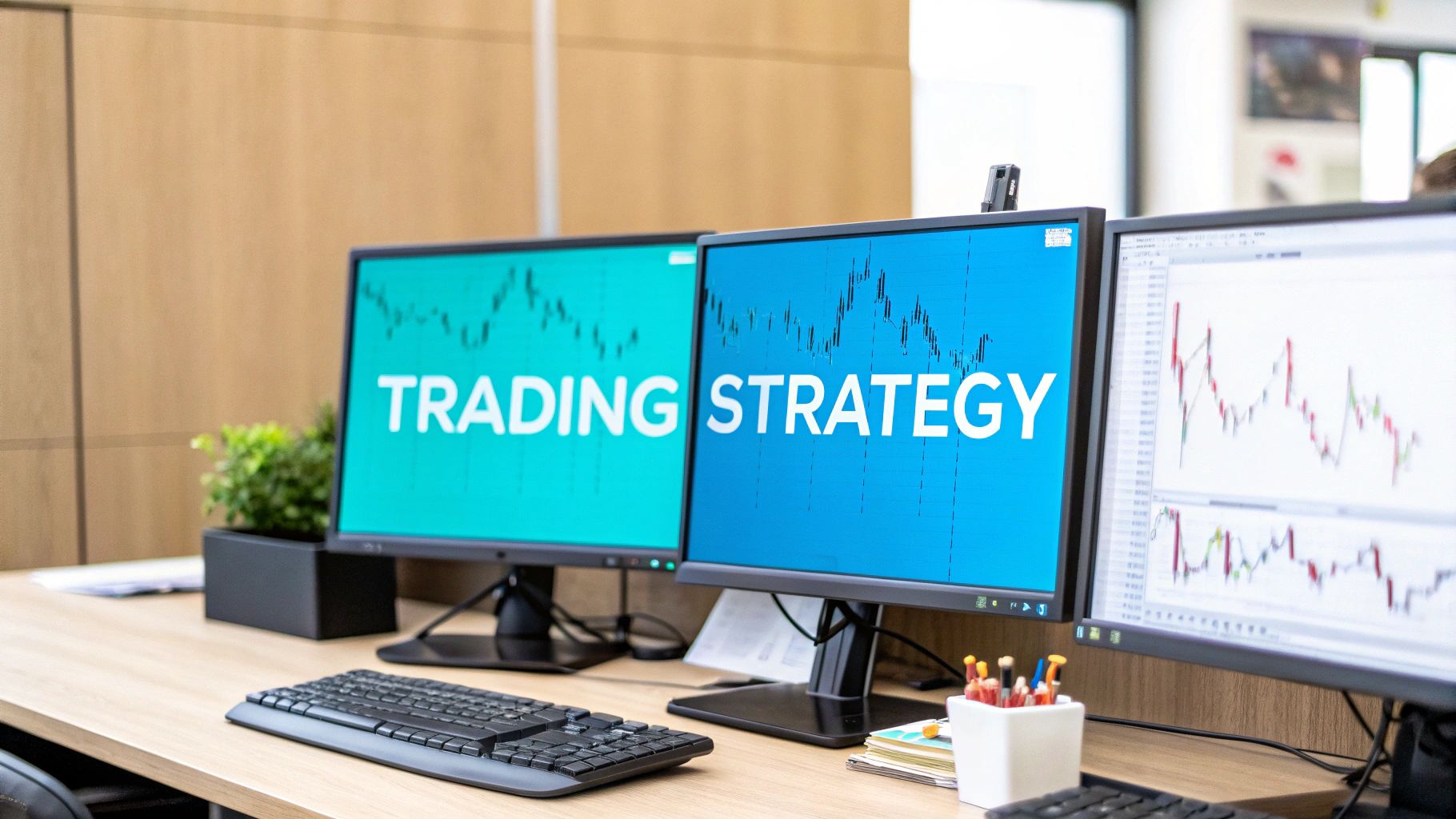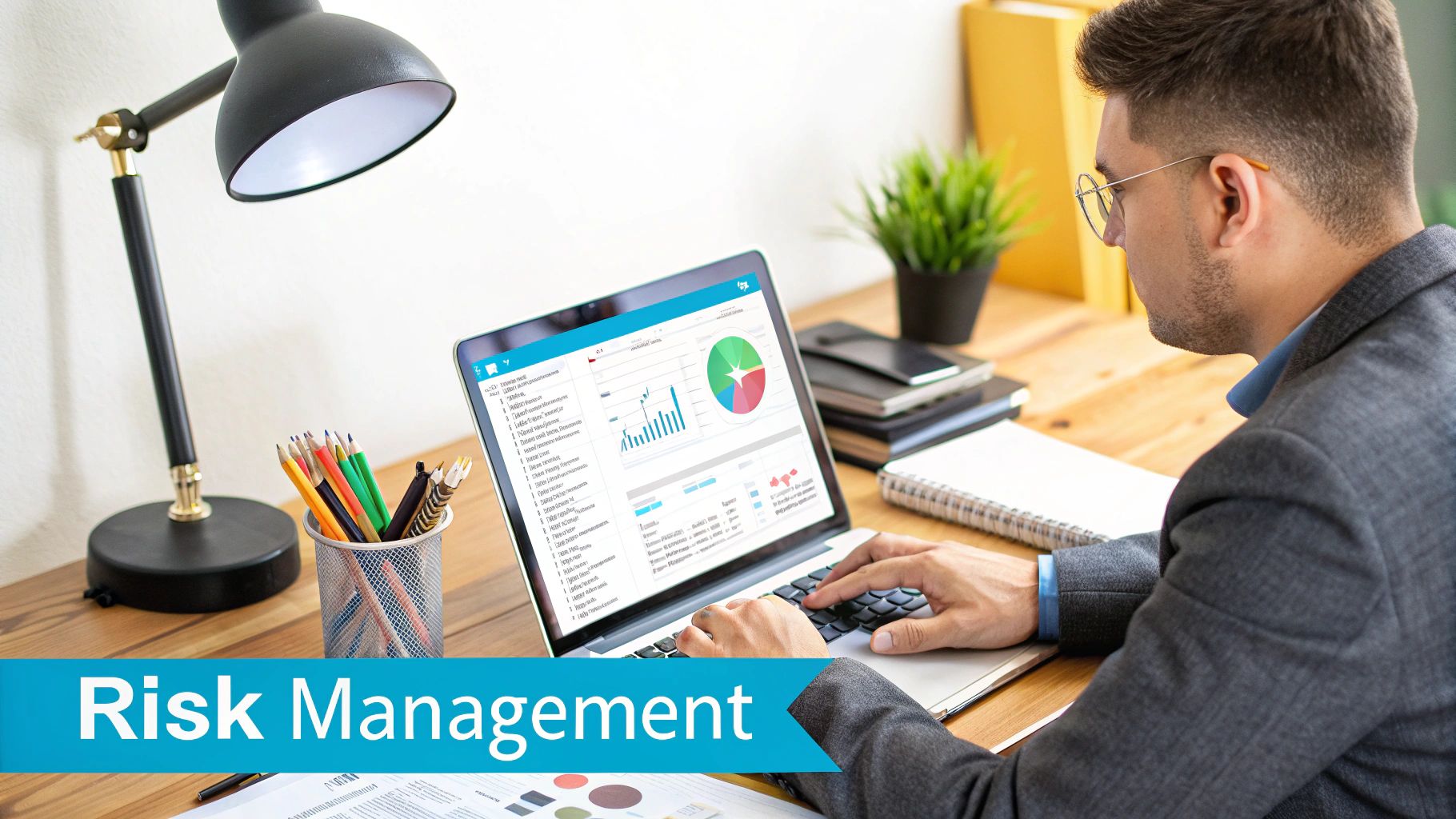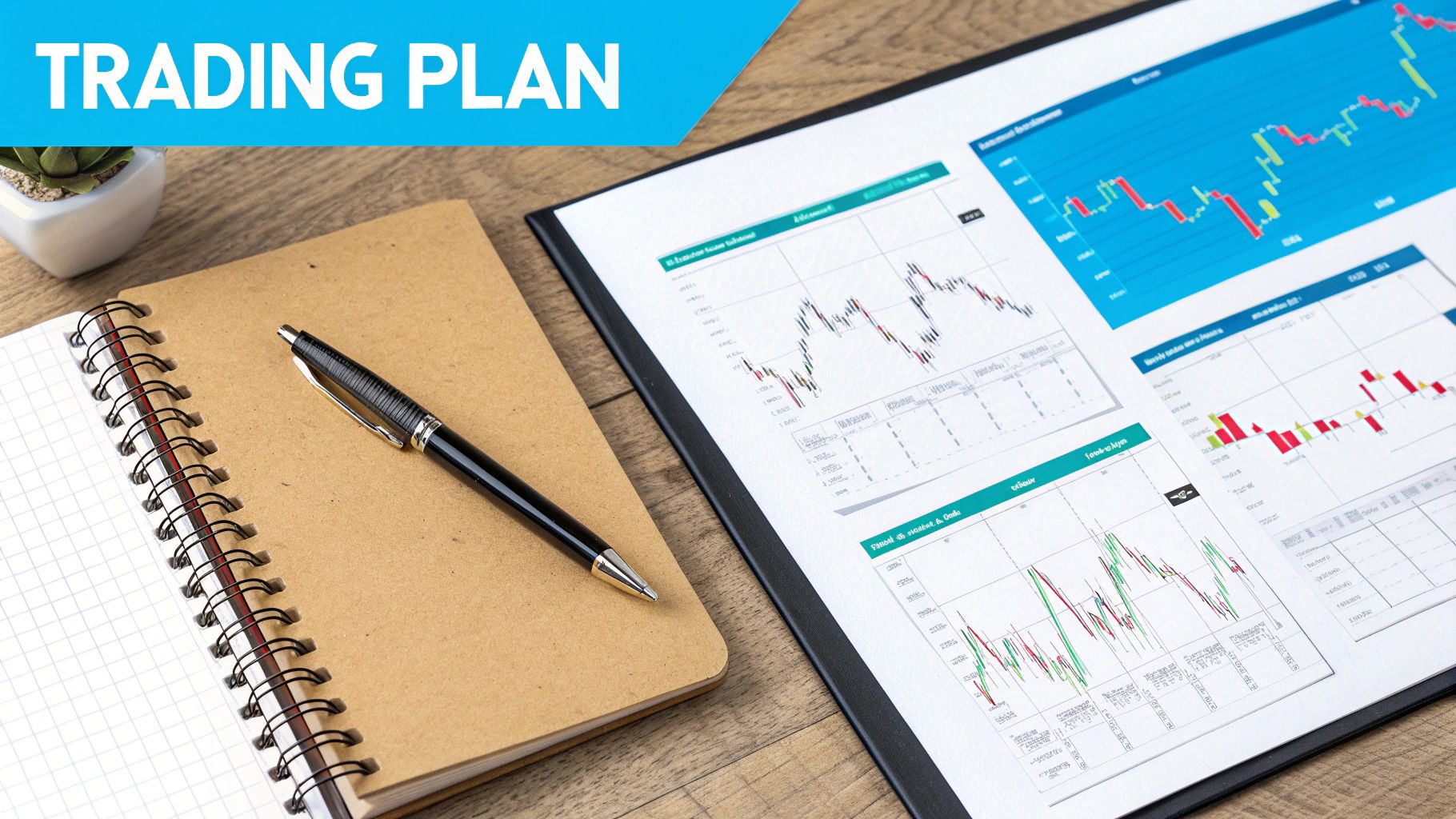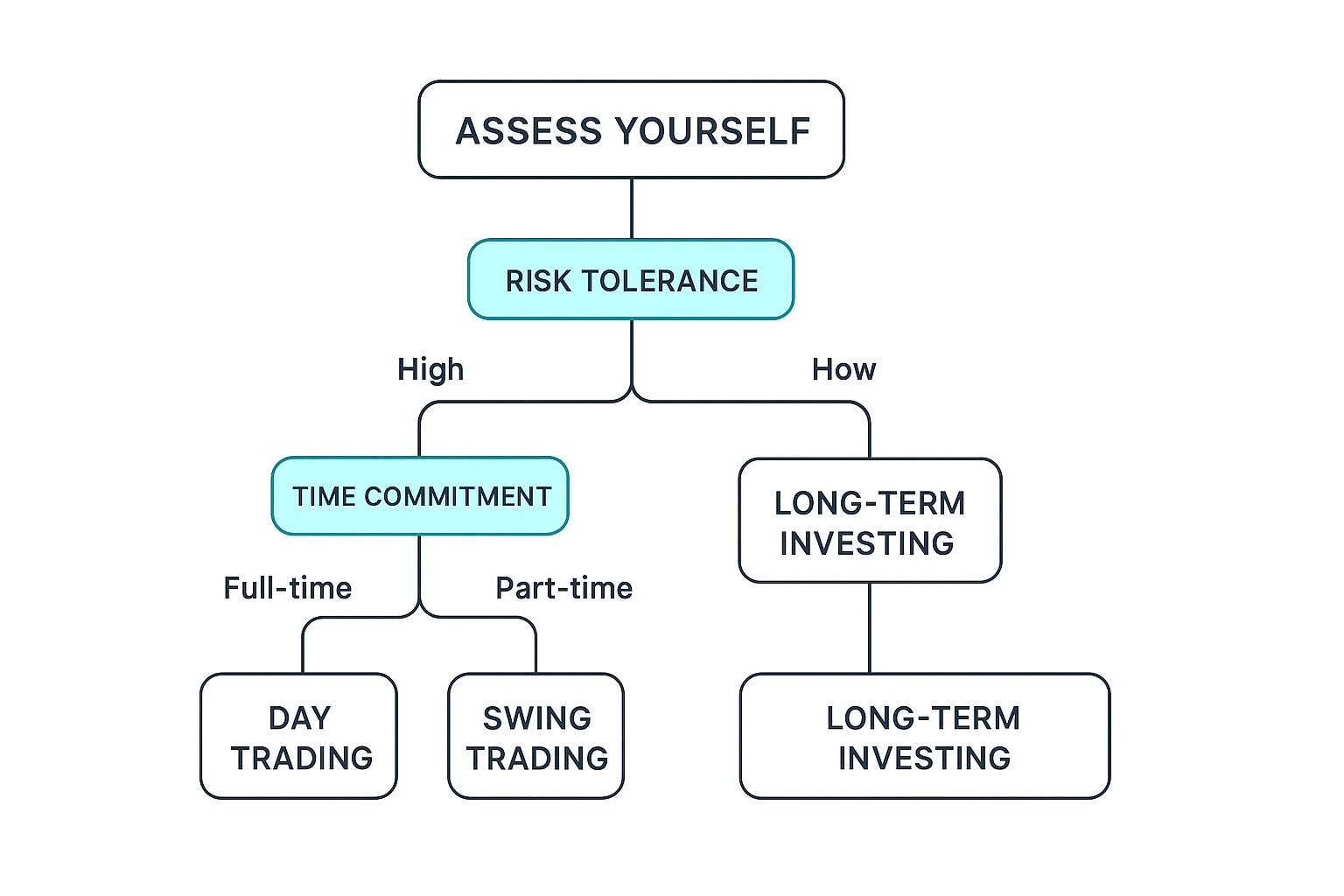




A good trading strategy is really just your personal rulebook. It tells you exactly when to get in, when to get out, and how to protect your money. It's not some magic formula—it's a framework you build to make consistent, clear-headed decisions instead of chasing lucky breaks.
Before you even think about placing a trade, you need to lay the groundwork. Think of it as drawing up the architectural plans for your trading business. Without a plan, you're not really trading; you're just gambling. A solid strategy takes the guesswork and emotion out of the equation, which is where most new traders trip up and fail. The goal here isn’t to find a flawless system, but to build a set of rules that actually works for you—your schedule, your personality, and your comfort level with risk.
This whole process forces you to ask the tough questions upfront, before a single dollar is on the line. It's a deliberate shift from a "get rich quick" mindset to building a sustainable skill for the long haul.
First things first, you need to decide what kind of trader you’re going to be. This mostly comes down to how much time you can realistically spend watching the markets. Your style will shape everything that follows, from the assets you trade to the chart timeframes you use.
For most people starting out, swing trading hits the sweet spot. It’s slow enough that you have time to think through your decisions, but you still get enough action to learn and adapt quickly.
Every solid trading strategy, no matter how simple or complex, stands on four pillars. Each one answers a critical question that you absolutely must have an answer for. If you skip one, it’s like building a house on three foundation walls—it’s just a matter of time before it comes crashing down.
A trading plan is your best defense against your worst enemy: yourself. When the market gets choppy, your gut will scream at you to break your rules. A written plan is that calm, objective voice you need to listen to in those moments.
Let's break down the four non-negotiable questions your trading plan must answer.
Answering these questions is what turns you from a passive spectator into a disciplined trader. It gives you the structure you need to handle whatever the market throws at you with confidence and lays the foundation for building a more advanced trading strategy for beginners that can grow with you.
Alright, you've got your basic trading framework sketched out. Now for the fun part: deciding where you'll trade and what tools you'll use to do it. This isn't about finding the fanciest platform or the wildest, most volatile market. For a beginner, the goal is to find a forgiving environment where you can learn the ropes without getting overwhelmed or draining your account on hidden fees.
The market you choose matters. A lot. It's tempting to jump straight into the fast-paced action of forex or crypto, but those markets can be ruthless. Their high volatility can wipe out a new trader's account in a hurry, making them a tough place to learn risk management and control your emotions.
A much smarter move is to start with markets that are more stable and easier to wrap your head around. This gives you the breathing room to actually practice your trading strategy for beginners without the constant stress of prices bouncing all over the place.
Here are a couple of solid starting points:
These markets generally have lower volatility and plenty of liquidity, which just means it’s easier to get in and out of trades at the price you expect. That stability is priceless when your main focus should be on executing your plan, not battling the market itself.
Your trading platform is your cockpit. A clunky, confusing interface is a recipe for expensive mistakes. When you're picking a broker and platform, look for simplicity and good support, not a million features you'll never touch.
Here’s what to zero in on:
Your platform and broker are your business partners. Choose them as carefully as you would anyone you're going into business with. Their reliability, costs, and tools directly affect how well you can execute your strategy.
Before you risk a single real dollar, you absolutely must test-drive your strategy in a simulated environment. We call this paper trading, and it's probably the most important step for building real confidence and skill. It lets you practice your entry and exit rules in real-time market conditions, but with zero financial risk.
Platforms like TradingView are perfect for this. You can connect a paper trading account and practice your strategy on live charts.

This is what it looks like—a standard chart with price action and indicators. It's the exact environment where you'll be testing your rules. Getting comfortable here builds the muscle memory you'll need for live trading, making sure you're ready when your own capital is on the line.

Alright, this is where a vague idea starts to become a real, actionable trading strategy. Let's be honest: trading without rock-solid rules for when to get in and out is just gambling. You're basically guessing, and the market is unforgiving of guesswork.
The whole point here is to build a system of rules so clear that there's absolutely no room for "what ifs" or second-guessing in the heat of the moment. You're not looking for a "good feeling." You're looking for a specific set of conditions to be met. Period. This mechanical mindset is what separates consistently profitable traders from those who ride an emotional rollercoaster.
Your entry trigger is the final green light. It’s the specific, observable event that tells you, "Now. Go." When you're just starting out, keep it simple. Overly complicated rules with a dozen different conditions will only lead to analysis paralysis.
A fantastic starting point for any trading strategy for beginners is using classic, proven indicators. Things like moving averages or simple price action patterns are perfect because they give you objective, visual cues right on your chart.
Let's walk through a simple, real-world example:
See how powerful that is? It’s a yes-or-no question. Did the candle close above the line? Yes or no? There’s no ambiguity, which is exactly what you need before putting your capital at risk.
Knowing when to get in is only half the battle. Knowing when to get out is arguably even more critical. For every single trade, you absolutely must define two exit points before you even click the buy button: one for taking your profits and another for cutting your losses.
This isn't optional. Without a pre-planned exit strategy, you're flying blind. You’ll find yourself closing winning trades too soon because you're scared, or clinging to losing trades because of a dangerous sense of hope.
Your stop-loss is your shield. It’s what protects your account from disaster. Your profit target is your discipline. It’s what keeps greed from turning a great trade into a terrible one.
Let’s stick with our moving average example. Here’s how you could map out the exits:
Planning this all out beforehand takes the emotion out of the decision-making process when your money is actually on the line.
To make your entry and exit rules even more reliable, you can start layering in other indicators for confirmation. Maybe you combine that moving average signal with a momentum indicator like the RSI (Relative Strength Index). The goal isn't to create a cluttered mess on your chart, but to find two or three tools that give you a more confident signal.
This is where EzAlgo's AI-powered tools can really give you an edge. They’re built to cut through the noise by putting clear buy and sell signals directly on your chart. Instead of trying to interpret several different indicators yourself, you get real-time signals that can serve as your primary triggers or confirm the rules you've already set.
For a deeper look at what's possible, check out our guide on the best entry and exit indicators available. It's all about taking the heavy lifting of analysis off your shoulders so you can focus on making smart, disciplined trades.
Let's get one thing straight. Forget about hitting grand slams right out of the gate. Your number one job as a trader is survival. That brings us to the most critical skill you’ll ever learn: risk management. You could have the most brilliant trading strategy in the world, but if a couple of bad trades can knock you out of the game, it's completely useless.
So, how do you actually protect your trading account? It all starts with a mental shift. You're not trying to be right on every single trade. That's impossible. Your real goal is to make sure your losses are small when you're wrong, and your wins are meaningful when you're right. This isn't just some feel-good trading mantra; it's the cold, hard math that keeps professionals in business for the long haul.
The bedrock of solid risk management is a simple but incredibly powerful guideline known as the 1% Rule. It’s exactly what it sounds like: you should never risk more than 1% of your total trading capital on any single trade. If you have a $5,000 account, your maximum loss on one position is capped at $50.
This rule is your best defense against emotional trading and the kind of catastrophic losses that end trading careers before they even get started. It turns a losing streak—which, trust me, every trader has—into a manageable dip instead of a complete account blowout.
Most seasoned traders I know would tell a beginner to risk somewhere between 0.5% and 1% per trade. As you gain more experience, you might inch that up to 2% on high-conviction setups, but when you're just learning the ropes, staying conservative is the only way to go. If you want to dig deeper into why this statistical approach is so powerful, check out our complete guide on advanced risk management techniques.
The 1% Rule tells you how much you can afford to lose, but it doesn't tell you how many shares or contracts to buy. That’s where position sizing comes in. This is the practical calculation that connects your risk rule to the "buy" button.
Position sizing is all about calculating the right number of shares for a trade based on your account size and where you place your stop-loss.
Let's walk through a real-world example:
Now for the simple math:$100 (Max Risk) / $2 (Risk per Share) = 50 Shares
That's it. That's your position size. By purchasing 50 shares, you've guaranteed that if the price drops and hits your stop-loss at $48, you'll lose exactly $100, sticking perfectly to your 1% rule.
The final piece of this puzzle is your risk-to-reward ratio (R:R). This just compares how much you stand to lose on a trade versus how much you stand to gain. A good R:R is what allows you to be profitable even if you lose more often than you win.
A great starting point for beginners is to aim for at least a 1:2 risk-to-reward ratio. In simple terms, you're trying to make at least $2 for every $1 you risk.
Your win rate doesn't determine your profitability—your risk-to-reward ratio does. You can be wrong 60% of the time and still make money if your winning trades are significantly larger than your losing ones.
Let's apply this to our ABC stock trade:
When you combine a smart position size with a positive risk-to-reward ratio, you create a strategy with positive expected value. This means that over many trades, you are statistically likely to come out ahead, even with a win rate of 50% or lower. One winning trade of $400 (at a 1:2 ratio) completely cancels out two losing trades of $200. It's this disciplined, math-based approach that separates hopeful gamblers from consistently profitable traders.

You’ve built a solid set of rules for your entries, exits, and risk. So, what’s next? Here’s the million-dollar question: how do you know if those rules actually work in the real world?
This is where theory gets a dose of reality. It's the moment a hopeful beginner starts the journey toward becoming a disciplined, data-driven trader. The biggest mistake you can make right now is assuming your strategy is profitable and jumping straight into live trading. Don't do it. You have to prove its viability first.
Testing and refining is what separates a trading strategy for beginners that just looks good on paper from one that can actually handle the pressure of live markets.
Backtesting is simply applying your trading rules to historical market data to see how they would have performed. While big firms have fancy software for this, you can do it effectively with nothing more than your charting platform. It's a vital step that builds both skill and confidence in your system.
Here's how I approach it manually, and how you can too:
I know, it sounds tedious. But this manual process forces you to burn your rules into your brain and spot your setups almost instantly. It’s like a basketball player shooting free throws for hours; it builds the muscle memory you absolutely need.
Your trading journal is, without a doubt, the single most important tool for getting better. This is where you go beyond just P&L and start to understand the why behind your results. Your backtesting data will be the first entries, and you’ll keep using this journal for every paper trade and real trade you ever take.
So, what should you be tracking?
After 100 trades, your journal will not lie. It will show you your true win rate, your average win versus your average loss, and which rules you tend to bend or break under pressure. This is the feedback loop that drives real improvement.
Analyzing this data shows you the objective truth. Maybe you'll find out your strategy stinks on Mondays, or that you consistently cut your winners short because of fear. This information is pure gold. It tells you exactly what part of your strategy—or your own mindset—needs work.
This discipline is what separates the pros from the rest. The numbers are sobering; research often shows that only about 4% of day traders find consistent success. This small group gets there not through genius, but through a hardcore commitment to a tested plan and constant adaptation. You can dive deeper into the realities of trading and see how successful traders handle dynamic market changes on tradethatswing.com.
A well-kept journal is your first step toward joining that small percentage.
Jumping into trading can feel like trying to drink from a firehose. As you start putting together your first trading strategy, it's completely normal to feel a bit lost. Let's walk through some of the most common questions and sticking points I hear from traders just starting out. This should help clear things up and reinforce the core ideas we've covered.
Choosing the right strategy really comes down to your personal situation, as this decision tree shows.

The biggest takeaway here is that there's no single "best" strategy for everyone. The right approach for you is a direct reflection of your own risk tolerance and how much time you can realistically spend watching the markets. With that in mind, let’s get into the nitty-gritty.
This is, without a doubt, the question I get asked the most. The answer is probably a lot less than you think. While some brokers have minimum deposits, the golden rule is to start with an amount you are 100% comfortable losing.
Think of this initial capital as your tuition. It's the price you pay for a real-world, hands-on education in the markets. For many, that might just be a few hundred dollars. This small amount forces you to focus on what truly matters: your process. You'll learn to follow rules, manage risk, and learn from mistakes without the crippling fear of losing your rent money. In the beginning, it's all about building good habits, not a fat bank account.
The honest answer? The "best" strategy is one that's simple, that you understand inside and out, and that you can execute with discipline day after day. A strategy that works wonders for a seasoned day trader could be a complete train wreck for someone else because it doesn't fit their schedule or personality.
A profitable strategy on paper is worthless if you can't actually stick to its rules. The best strategy is the one you can follow without letting fear and greed hijack your decisions.
For most beginners, I recommend starting with a trend-following or a support-and-resistance strategy on a longer timeframe, like the daily charts. These approaches are much slower-paced than intense day trading. This gives you more breathing room to analyze the market and make decisions with a clear head. Your goal is to find a system you can execute almost mechanically, which is the key to taking emotion out of the equation.
Making the jump from a practice account to live trading is a massive step. Before you even think about it, you need objective proof that your strategy works and—just as important—that you can follow it. You should only consider trading with real money after you’ve met a few strict criteria.
First, you need to have paper traded for at least one to two months, keeping a meticulous record in your trading journal. This journal must contain a minimum of 50 to 100 trades.
This data needs to prove two things, loud and clear:
If you find yourself constantly breaking your own rules with fake money, you have zero chance when real emotions and capital are on the line. Master the process in a simulated environment first. Only then have you earned the right to put your hard-earned money at risk.
Ready to stop guessing and start trading with data-driven confidence? EzAlgo provides the AI-powered signals and automated tools you need to build and execute a smarter trading strategy. Our suite of indicators is designed to give you a clear technical edge, helping you identify high-probability setups and manage risk like a professional. Explore our tools and join a community of traders committed to a more disciplined approach at https://www.ezalgo.ai.